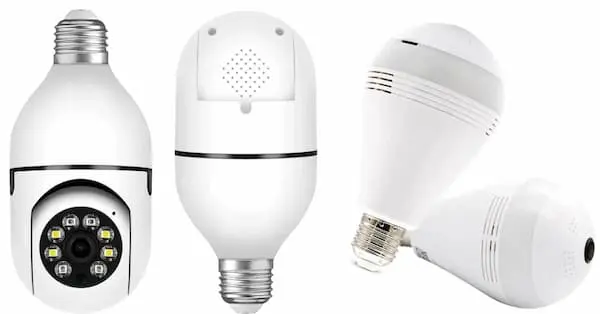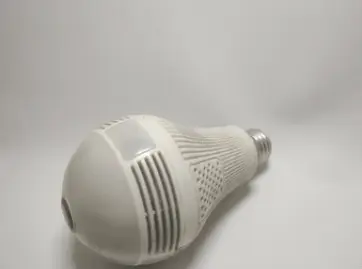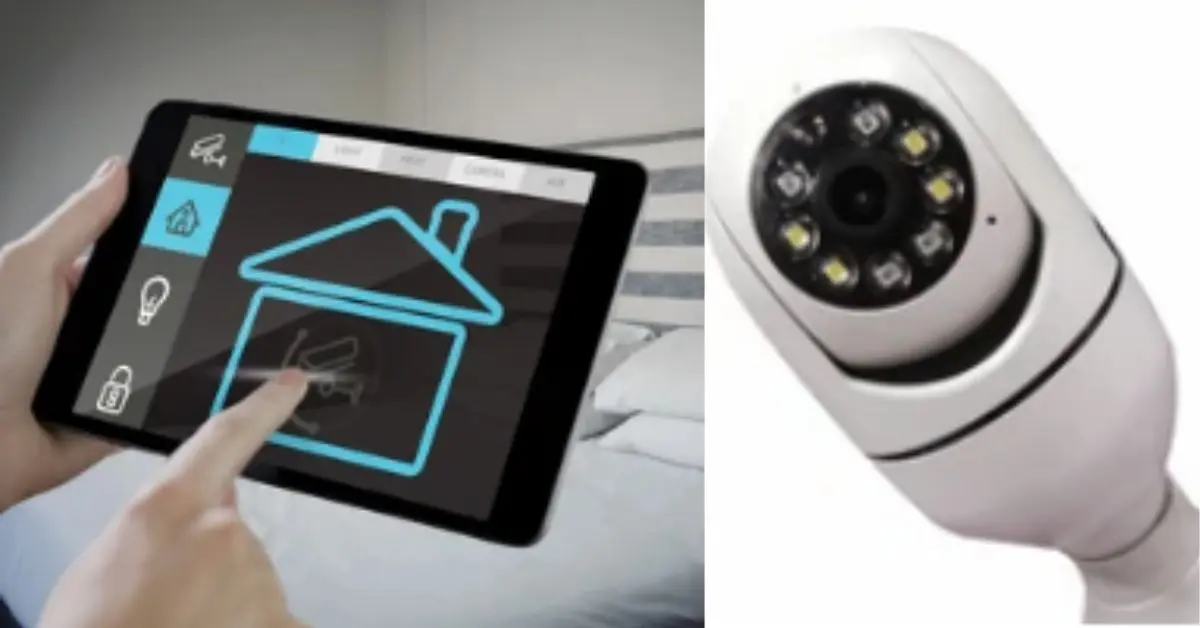Light bulb cameras are revolutionizing home security and surveillance systems. Combining the functionality of a light source with the discreetness of a camera, these devices provide a seamless solution for monitoring spaces while blending into the environment.
In this article, we will delve into how do light bulb cameras work, revealing the intricate fusion of lighting and surveillance technology that has transformed the realm of home security.
Table of Contents
Unveiling Light Bulb Cameras

At first glance, a light bulb camera appears inconspicuous, resembling a typical light fixture found in homes or offices.
However, concealed within its unassuming design lies a potent surveillance camera equipped with a suite of features designed to capture, process, and transmit audio and video data.
Their ability to effortlessly merge with surroundings, often mimicking conventional light bulbs, makes them discreet tools ideal for covert surveillance.
Why its Important to Know How Light Bulb Cameras Work?
Understanding how do light bulb cameras work is crucial as it allows users to grasp the intricacies of their functionality, enabling informed decisions when it comes to purchasing, installing, and utilizing these devices for effective home security.
It empowers individuals to maximize the potential of these cameras, ensuring proper integration into existing systems and optimizing their surveillance capabilities to safeguard homes and properties efficiently.
The Anatomy of Light Bulb Cameras
To comprehend how do light bulb cameras work, let’s delve into dissecting their integral components and operational mechanics:
- Camera Lens: Serving as the eye of the camera, the lens captures images and videos with precision.
- Image Sensor: This crucial component converts optical images into electronic signals, ready for processing.
- Processor Unit: Responsible for managing data processing and compression, optimizing it for storage and transmission purposes.
- Connectivity Module: Facilitating communication through Wi-Fi networks for remote access and control.
- Light Source: Equipped with LED lights, providing illumination for the surrounding area.
- Storage: Housing recorded footage, often utilizing microSD cards or cloud storage for accessibility and safety.
- Motion and Sound Sensors: Activating recording upon detecting motion or sound, fortifying security measures.
How do Light Bulb Cameras Work: Understanding Functionality

Capturing Footage
Upon activation, the camera lens initiates the process of capturing footage, which is then relayed to the image sensor.
This sensor swiftly translates visual data into digital information, while the processor unit optimizes and compresses the data for efficient storage and transmission.
Transmission and Connectivity
Most light bulb cameras seamlessly connect to Wi-Fi networks, facilitating remote access and control via dedicated mobile apps or web interfaces.
This connectivity enables live streaming of footage to smartphones or computers, providing real-time monitoring from anywhere with internet access.
Storage Options
Recorded footage finds storage through various means. Some cameras incorporate local storage using microSD cards within the device, while others leverage cloud storage services, ensuring accessibility to recordings from any location with an internet connection.
This redundancy ensures data safety and accessibility even in adverse scenarios.
Motion and Sound Detection
Still wondering how do light bulb cameras work?
Enhancing their security capabilities, advanced light bulb cameras are equipped with motion and sound sensors. These sensors promptly detect environmental changes, triggering the camera to initiate recording.
Users receive instantaneous notifications on their mobile devices upon motion or sound detection, enabling swift responses to potential security threats.
How to Install Light Bulb Cameras
With an understanding of how do light bulb cameras work, let’s delve into the typical installation process which involves the following steps:
- Selecting the Location: Choose an area with a clear view of the desired surveillance area. Ensure it’s within the Wi-Fi range for proper connectivity.
- Turning Off Power: Switch off the power supply to the light fixture where you intend to install the camera. Safety first!
- Removing Existing Bulb: Unscrew and remove the existing light bulb from the socket.
- Mounting the Camera: Carefully place and secure the light bulb camera into the empty socket. Ensure it’s snugly fitted without obstructing the camera lens.
- Connecting to Power: Turn the power supply back on. The light bulb camera usually powers up and begins setup. Configure the setup by following the manufacturer’s guidelines to connect the camera to your Wi-Fi network.
- Installing the App: Download the dedicated app provided by the camera manufacturer on your smartphone.
- Pairing the Camera: Follow the app’s instructions to pair your smartphone with the camera. This step usually involves scanning a QR code or following on-screen prompts.
- Adjusting Settings: Configure settings such as motion detection, recording preferences, and notification alerts according to your preferences using the app.
- Testing: Ensure the camera is functioning properly by testing the live feed and adjusting the angle if necessary.
- Securing the Network: Set a strong password for the camera and ensure your Wi-Fi network is secure to prevent unauthorized access.
- Regular Maintenance: Periodically check the camera for any issues, clean the lens, and update the camera’s firmware as recommended by the manufacturer.
Remember, these steps may vary slightly based on the specific model and manufacturer’s instructions. Always refer to the provided user manual or installation guide for precise instructions tailored to your light bulb camera.
Advantages of Light Bulb Cameras
Discreet Surveillance
The primary advantage of light bulb cameras lies in their discreet nature. Blending seamlessly into their surroundings, these devices maintain a low profile, providing covert surveillance without drawing attention.
Dual Functionality
By integrating a light source with surveillance capabilities, these devices offer a dual purpose of illuminating spaces while providing surveillance, maximizing practicality and utility.
Remote Monitoring and Accessibility
The convenience of remotely accessing live footage via smartphones or computers provides unparalleled peace of mind. Real-time monitoring enhances security, especially during periods of absence, offering reassurance to homeowners.
Limitations and Considerations
Limited Field of View
Certain light bulb cameras may offer a limited field of view compared to traditional security cameras. Opting for models providing a 360-degree view or strategically placing multiple cameras may be necessary for comprehensive coverage.
Connectivity Issues
Reliable internet connectivity plays a pivotal role in the seamless functioning of light bulb cameras. Network disruptions or slow internet speeds can compromise the quality of live streaming and remote access, affecting their effectiveness.
Security Concerns
Like any device connected to the internet, ensuring security and privacy is of utmost importance. Implementing robust passwords and regularly updating the device’s software are imperative to mitigate potential hacking risks and safeguard sensitive data.
Factors to Consider Before Purchasing

Having explored how do light bulb cameras work, it’s essential to consider following pivotal factors before making a purchase decision.
Connectivity Options
Understanding the compatibility of these cameras with various devices and networks is crucial. Some models might require specific routers or connectivity settings for optimal performance.
Compatibility
Ensuring the compatibility of the camera with existing smart home systems or applications is essential to streamline the monitoring process. Compatibility ensures seamless integration into the existing setup.
Features and Specifications
Analyzing the features like resolution, night vision, storage options, and remote access capabilities helps in making an informed decision.
Assessing these specifications helps determine if the camera meets specific surveillance needs and preferences.
Effective Applications of Light Bulb Cameras at Home

Home Security
- Entryway Monitoring: Overseeing entrances like front doors or garages for security purposes.
- Interior Surveillance: Monitoring indoor spaces for any suspicious activities or intrusions.
- Pet Monitoring: Keeping an eye on pets when away from home.
Child Safety
- Baby Monitoring: Watching over infants or young children in their rooms.
- Nanny Cam: Ensuring the safety and well-being of children under the care of a nanny or caregiver.
Home Automation
- Integration with Smart Home Systems: Incorporating light bulb cameras into smart home setups for centralized monitoring.
- Remote Access: Checking in on home surroundings from anywhere using smartphone applications.
Elderly Care
- Monitoring Elderly Relatives: Keeping an eye on elderly family members to ensure their safety and well-being.
- Emergency Response: Providing a means to quickly respond in case of emergencies or medical situations.
Package Delivery Surveillance
- Monitoring Deliveries: Keeping track of package deliveries and deterring package theft.
General Monitoring
- General Surveillance: Keeping a check on overall home activities, both indoors and outdoors.
Beyond residential use, light bulb cameras find application in various settings. From offices and retail spaces to hospitality and public venues, their discreet nature and versatile functionality make them an asset in diverse security setups.
Common Mistakes to Avoid When Using Light Bulb Cameras
- Poor Placement: Avoid placing the camera where it can be easily obstructed or where its view is limited, compromising its effectiveness.
- Neglecting Connectivity: Ensure the camera is within a strong Wi-Fi range to maintain a stable connection, preventing issues like lag or disconnections.
- Forgetting Maintenance: Regularly check and clean the camera lens, and update its firmware to maintain optimal performance.
- Weak Security Measures: Using weak passwords or neglecting software updates can compromise the camera’s security, leading to unauthorized access.
- Ignoring Compatibility: Not checking the camera’s compatibility with existing devices or networks can cause integration issues, impacting functionality.
Future Developments
Continual advancements in technology promise further improvements in light bulb camera capabilities.
Enhanced resolution, wider fields of view, and improved connectivity are among the anticipated developments, bolstering their efficacy in safeguarding spaces.

Conclusion
Light bulb cameras represent an innovative blend of illumination and surveillance technology, providing discreet and functional solutions for home security.
Understanding how do light bulb cameras work is crucial for users, aiding informed decisions in utilizing these devices effectively for surveillance, ensuring optimal security measures.
Their seamless integration into our living spaces coupled with advanced features signifies a paradigm shift in home security, promising greater safety and peace of mind for users worldwide.
FAQs
- Do light bulb cameras work in the dark? Yes, most light bulb cameras come equipped with night vision capabilities, allowing them to capture clear footage even in low-light or dark conditions.
- Can these cameras be hacked easily? Security measures are implemented by reputable manufacturers to prevent hacking. However, it’s crucial to use strong passwords, update firmware regularly, and employ secure networks to minimize potential vulnerabilities.
- What is the average lifespan of a light bulb camera? The lifespan varies among models but typically ranges from 2 to 5 years. Regular maintenance and adherence to manufacturer guidelines can extend this duration.
- Are light bulb cameras suitable for outdoor use? Most light bulb cameras are designed for indoor use due to factors like weather exposure. However, some models explicitly built for outdoor use are available in the market.
- Do light bulb cameras record audio as well? Yes, many light bulb cameras come with built-in microphones to capture audio alongside video footage. However, it’s essential to review local laws and regulations regarding audio recording for privacy considerations.
Thanks for reading our post on how do light bulb cameras work. Visit MyTechBlogz for more informative posts.
